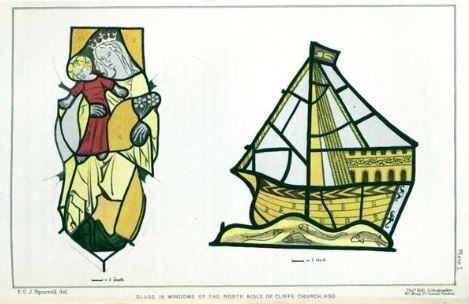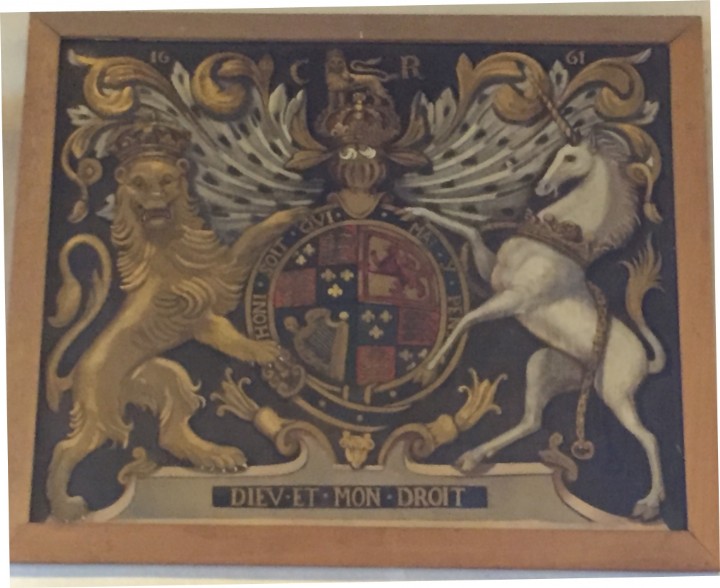The North Aisle
The North Aisle is generally similar. The wooden ceiling, however, is more interesting with its hammer beams and carved shields where it rests upon the corbels. The roof of this aisle was restored to its present high pitch in 1886 according to an entry in the Parish Magazine of December of that year.
At the east end remains of an ancient lancet window are visible above what appears to have been a doorway that faced west out into the open. This would have been prior to the widening of the aisle. Observation of the arch opening into the north transept reveals the possible slope of the 13th century lean-to aisle. No piscina is in evidence near the place where the altar would have stood, but a certain hollowness of the wall nearby could be a clue. A window of interest is the one on the north wall containing a small section of stained glass with a ship as the subject. The origin of the glass and how it came to be incorporated in this particular window is unknown. The ship is clearly of Northern type, though her superstructure owes something to Italian and Flemish style. Certainly an ocean-going vessel, of 50-70 tons. Clearly 15th century and probably circa 1430-70. The ship is not a ‘cog’, the ordinary medieval trader, which was obsolete by 1400. Nor is she a fully fledged ‘carrack’. Probably something between the two. Such a vessel might have been in the Flanders cloth trade or the Gascony wine trade. With Cliffe once reputed to be a trading port, this could be possible. The fact that this glass is placed in a window nearest the Thames may not be without significance.

The West end of this Aisle was a Bone-hole a hundred years ago. This was where the glass was found by the choirboys as is recorded by Mr. G. H. Payn. It was the place where the sexton kept his grave digging equipment, a very neglected corner which we know was an area where the paving was all broken up and was generally regarded as a ‘dark place’. In 1972 this part of the North Aisle was converted into a chapel for the children. The Altar now standing here was the High Altar until 1953. The brass candlesticks are dedicated to the memory of “Annie Potter died 7th February 1948 aged 80” and were presented by a relative.
The Royal Arms were originally in the Choir vestry, but were restored and fixed in their present position in 1961 as a memorial to the late “Thomas James Hutchings, B.A. Headmaster of St. Helen’s School Cliffe 1939 - 1958”. Royal Arms were ordered to be, placed in all churches following the return of Charles the Second and the Restoration of the Monarchy. This is the reason the Arms of this particular king are the ones most commonly found in churches. It must have been a pleasure to welcome a little colour into these buildings again after the long drab years of Puritanism.

The Royal Court of Arms ordered by Charles II after the restoration of the monarchy.
The significance of the two hatchments is not known. In earlier times a hatchment was hung on the front of the house of a land-owner to indicate his death. It was later hung in the church where the family normally worshipped.
The nearby door is of fine solid oak and similar in design to the South door. Note the iron work which suggests the same hand. The original 8” key is still in use.
